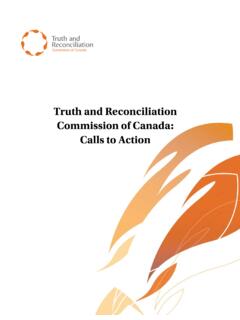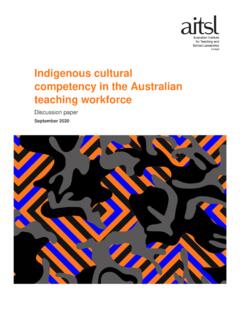Transcription of Science - Narragunnawali
1 Page | 1 Resource Guide Science The information and resources contained in this guide provide a platform for teachers and educators to consider how to effectively embed important ideas around reconciliation, and aboriginal and Torres Strait Islander histories, cultures and contributions, within the specific subject/learning area of Science . Please note that this guide is neither prescriptive nor exhaustive, and that teaching staff are encouraged to consult with their local aboriginal and Torres Strait Islander community, and critically evaluate resources, in engaging with the material contained in the guide. Page 2: Background and Introduction to aboriginal and Torres Strait Islander Science Page 3: Timeline of Key Dates in the Contemporary History of aboriginal and Torres Strait Islander Science Page 5: Recently Released aboriginal and Torres Strait Islander Science Resources Page 9: aboriginal and Torres Strait Islander Scientists Page 10: aboriginal and Torres Strait Islander Science Groups/Organisations/Programs Page 11: aboriginal and Torres Strait Islander Science Celebrations/Events Page 12: Other Online Guides/Reference Materials Page 13: Reflective Questions for Science Staff and Students Please be aware this guide may contain references to names and works of aboriginal and Torres Strait Islander people that are now deceased.
2 External links may also include names and images of those who are now deceased. Page | 2 Background and Introduction to aboriginal and Torres Strait Islander Science Indigenous Australia has some of the world s earliest scientists and inventors, who have witnessed major astronomical and catastrophic events like tsunamis, meteorites, floods, and entire ice ages, and fortunately have survived to tell the story. Long before the Greeks were studying the stars Indigenous Australians were developing highly sophisticated 1 Luke Briscoe, aboriginal Scientist It is important to appreciate that, while this guide focuses as much on aboriginal and Torres scientific conventions and collaborations since colonisation, Science has been an integral part of aboriginal and Torres Strait Islander cultures for thousands of years, and continues to play an integral part in cultural life to this day.
3 It is also important to acknowledge that, from aboriginal and Torres Strait Islander perspectives, there is an intricate and inextricable interconnection between the physical, chemical and biological sciences and the social sciences more widely, particularly because of the deep and timeless relationship between Country and aboriginal and Torres Strait Islander identities, languages, cultures and spiritualties. Indeed, in the words of Palawa woman and aboriginal Science educator, Angie Abdilla, within an Indigenous paradigm, Indigenous sciences are not segregated but part of all aspects of our culture and lore. 2 For this reason, you may wish to consider the content in this subject guide in the context of some of the content organised within other Civics and Citizenship, Economics and Business, Geography, Health and Physical Education, History, Languages, Mathematics, and Technologies subject guides.
4 For generations, aboriginal and Torres Strait Islander sciences have incorporated, but not been limited to, sophisticated knowledges and practices pertaining to seasons and meteorology; astrology and astronomy; bush food, medicine and healing ; natural resource management; and the physics and chemistries behind the design, production or use of tools, instruments and inventions. Unfortunately, aboriginal and Torres Strait Islander Science traditions suffered significantly under oppressive colonial government policies that both directly and indirectly separated aboriginal and Torres Strait Islander children from their cultures and communities. Colonial prejudices too often propagated a myth that aboriginal and Torres Strait Islander sciences were primitive or less than , rather than acknowledging the important roles that these sciences can and do play in sustaining Australia s ecosystem and economy alike.
5 Nevertheless, aboriginal and Torres Strait Islander peoples and scientific knowledges/practices have also shown incredible resilience and adaptability over time. They are increasingly recognised and respected as being integral to contemporary conversations and collaborations around some of the biggest scientific questions of today, such as food security and climate change. In engaging with some of the resources referenced throughout the remainder of this guide, remember to consider their great relevance to the future of Science education, and to reconciliation in education more broadly. 1 Reference: Briscoe, L. (2016) Indigenous Science is at the core of social, economic and political change, SBS/NITV, < > 2 Ibid Page | 3 Timeline of Key Dates in the Contemporary History of aboriginal and Torres Strait Islander Science This timeline chronologically lists some of the key dates in the more recent history of aboriginal and Torres Strait Islander Science and/or in regard to the relationship between Science and reconciliation more generally.
6 60,000+ years ago: - aboriginal and Torres Strait Islander communities across Australia have maintained longstanding conventions, conceptualisations and connections pertaining to Science for tens of thousands of years. For example, The Brewarrina fish traps demonstrate a strong scientific knowledge and understanding of tidal patterns and are approximately 40,000 years old, making them one of the oldest manmade structures on earth. As a further example of significance, the Wurdi Youang stone arrangement maps out the movements of the sun and is more than 11,000 years old (pre-dating Stonehenge and even the Great Pyramids of Giza). 1909: - By 1909, aboriginal scientist/inventor, David Unaipon, had developed and patented a modified handpiece for shearing. Between this year, and 1944, he made patent applications for nine other inventions, including a centrifugal motor, a multi-radial wheel and a mechanical propulsion device, building his reputation as Australia s Leonardo da Vinci.
7 1974: - The archeological discovery of Mungo Man (and Mungo Lady in 1968) fossils near Lake Mungo, NSW, provided scientifically backed evidence that doubled the known length of aboriginal history in Australia. 1980: - The Centre for Appropriate Technology (CAT) was established, growing to become a peak national Indigenous Science and technology organisation. 1989: - The Worldwide Indigenous Science Network was founded, which aboriginal and Torres Strait Islander scientists from Australia have since been a part of (see Luke Briscoe s reflections on a 2016 collaboration here, for example). 1995: - Image of aboriginal inventor, David Unaipon, was first printed on the Australian $50 note. 2004: - The National Indigenous Science Education Program (NISEP) was established, when scientists from Macquarie University began collaborating with Elders from the Yaegl and Bundjalung communities of northern NSW on bush medicine projects.
8 Page | 4 2012: - The Australian Government Department of Industry, Innovation and Science released its Indigenous Engagement with Science : Towards Deeper Understandings report, prepared by the Expert Working Group on Indigenous Engagement with Science to acknowledge the significant contributions that aboriginal and Torres Strait Islander peoples have already made to the development of Science in Australia, and the urgency to communicate the continued importance of engaging aboriginal and Torres Strait Islander peoples in Science to the scientific and broader Australian community. - Bill Gammage publishes book The Biggest Estate on Earth dispels the myth that pre-settlement Australia was an untamed wilderness revealing the complex, country-wide systems of land management used by aboriginal people. 2014: - CSIRO launches its Indigenous STEM Education Project, recognising the important contributions that aboriginal and Torres Strait Islander peoples can make to the future of the Science , technology, engineering and maths industries in Australia.
9 2016: - A world-first genomic study confirms that contemporary aboriginal and Torres Strait Islander peoples are the descendants of the first people to inhabit Australia. - INDIGI LAB was founded with a vision to create a future where aboriginal and Torres Strait Islander Australians are leading in Science , technology and digital innovation. It also launched Australia s first aboriginal and Torres Strait Islander Science and Technology magazine, STREAMS IQ. - The CSIRO launched its inaugural Indigenous STEM Awards. - Bruce Pascoe s Dark Emu wins the NSW Premier's Literary Awards the book challenges the perception of pre-colonial aboriginal people as 'hunter-gatherers', and provides compelling evidence from the diaries of early explorers that suggests that systems of agriculture, food production and land management have been blatantly understated in modern retellings of early aboriginal history.
10 Page | 5 Recently Released aboriginal and Torres Strait Islander Science Resources Organised below are a number of examples of recently produced or published aboriginal and Torres Strait Islander Science -related resources that can meaningfully contribute to contemporary classroom learning, and to the range of biological, chemical and physical fields of Science in Australia as a whole. aboriginal and Torres Strait Islander Seasonal Calendar Resources The list below includes a number of examples of aboriginal and Torres Strait Islander seasonal calendars. The traditional ecological and meteorological knowledges captured in these calendars have become well esteemed within Western Science for what they can teach wider society about environmental management and sustainability, and about understanding and approaching contemporary Science issues such as climate change.





